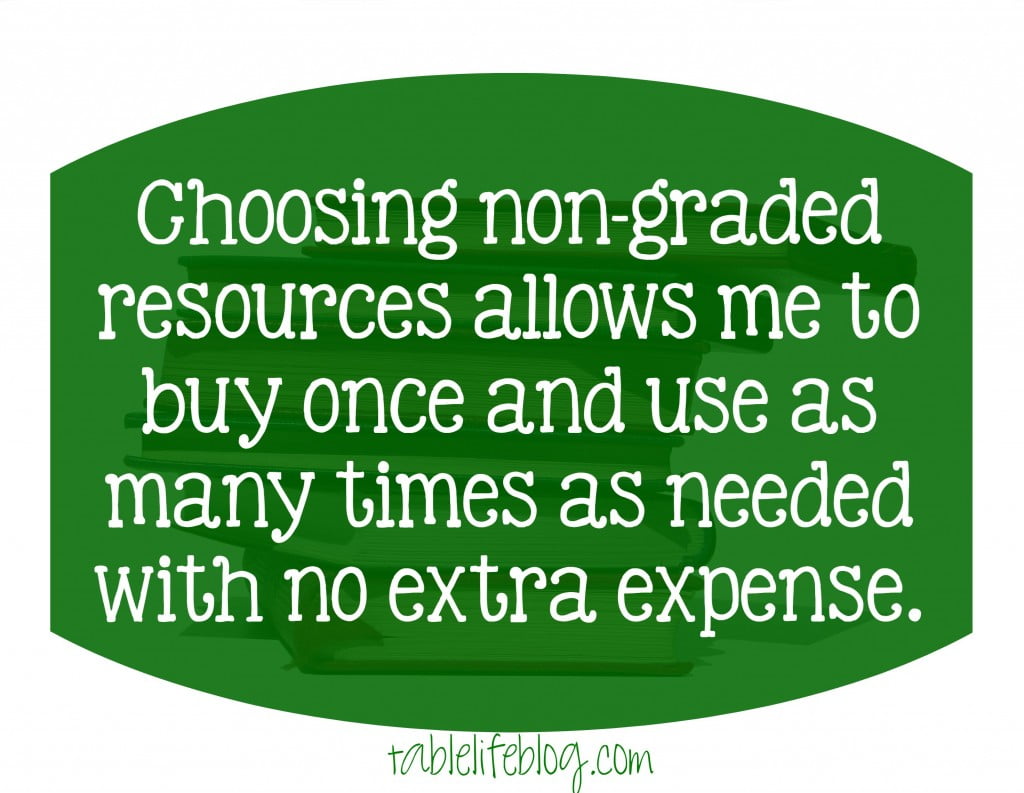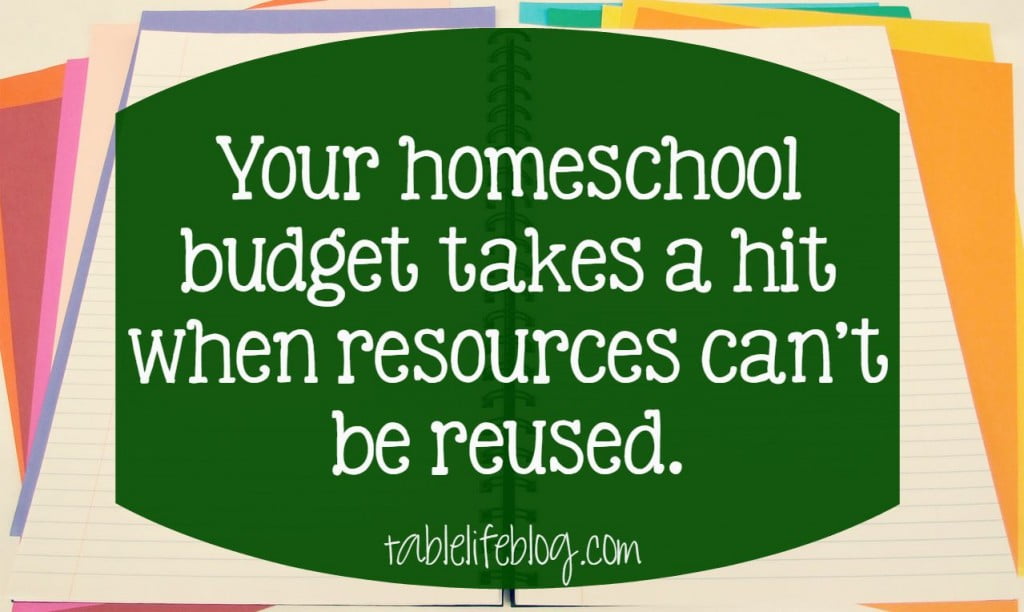I’m not proud of how long it took me identify the homeschool budget busters and get rid of them. But, fear not! You don’t have to make the same mistakes with your homeschool budget. You can skip that step and learn from mine.
Say goodbye to the budget busters and say hello to homeschool resources that have staying power.


(This post contains affiliate links; please see disclosure for details.)
My children have a difference of five years in age between them. We started homeschooling my eldest when he was a preschooler. That’s probably why it took me so long to understand budget busters. You see, budget busters don’t always show themselves when you’re homeschooling an only child or a younger child.
We avoided budget busters without problems until a few years ago. Up until that point, I selected The Boy’s curriculum by grade level. I also looked for items that were inexpensive but would serve the purpose I needed at the time. That all seems okay, right?
What I learned along the way was that buying according to grade level was putting major constraints on our homeschool and our budget at the same time. Not cool.
Counting the Cost: Graded Curricula Vs. Nongraded Curricula
Curriculum written and organized according to grade level isn’t necessarily a bad thing, but it’s definitely not the most budget friendly way to go, especially for families with children close in age. Many homeschool families, us included, opt for non-graded homeschooling and for lots of good reasons. On the other hand, some families feel that staying in step with public schools is a high priority and feel that non-graded homeschooling isn’t a good match.
For the sake of cost comparison, consider the costs of Sassafras Science Adventures and the BJU Third Grade Science line. Sassafras Science is a non-graded, topical resource for science that also happens to be one of our favorites.
BJU is a reputable Christian education publisher that produces curricula for private schools and homeschooling. BJU’s curriculum is written to grade level and covers multiple topics within each subject throughout the course of the texts. We haven’t personally used BJU’s science materials, but we have used their math curriculum before and know their science line is similarly formatted.
Why Graded Homeschooling Costs
From a financial perspective, choosing a graded curriculum often means purchasing a whole slew of curricula and extra items per subject, per child. That adds up quickly enough for one child, but it’s a definite budget buster for homeschools with more than one child at the table.
For example, BJU’s 3rd grade science package is more than $300 if purchased new. That amount multiplied times the number of subjects you wish to cover is a significant expense. Then multiply that amount per child and there’s even more expense.
From a teaching standpoint, using graded curriculum means the kids are all learning different things at different times. That often causes challenges for parents who wish to have active involvement in their kids’ homeschool days.
It also means there’s not much wiggle room in the schedule. If unforeseen scheduling conflicts arise or life happens, it’s hard to adjust without the threat of being behind a grade level.
Non-graded homeschooling makes sense (& cents).
Financially speaking, a nongraded line like Sassafras Science Adventures is much more budget-friendly. I can buy it once, use it to teach both of my kids, and not need an additional line of resources in order to use it again.
What’s more, if kids are generally the same age, the only additional resource needed would be another student guide. With that addition, they could be taught at the same time, which means you, the teacher, are teaching the same science lesson once rather than covering different scopes of material with each child.


As far as teaching is concerned, choosing a non-graded resource like this means we can cover topics within each subject when they best suit us. It’s also nice because it’s easy to adjust if things aren’t going according to plan or if we choose to stay on a topic for longer than expected. That’s important because you can take as long as you need without letting grade level labels control your schedule.
On the other hand, a graded resource like BJU’s Science 3 text requires additional purchases of the activities manual, tests, and teacher’s guides for the text and activities manual. All of those additions are usually necessary in order to use the curriculum and they usually come with a big pricetag.
It’s easy to see why non-graded materials are the way to go if you want to make over your homeschool budget. Using a topical, non-graded resource instead of a grade level curriculum that requires a matching product line makes lots of financial sense even for homeschooling one child. The savings are even sweeter when using that non-graded resource a second time around!
Consumable curriculum options *CONSUME* your budget.
Consumables are resources that can only be used once, like workbooks; unfortunately, consumable materials also fall into that budget buster category.
Many families enjoy using traditional grade-level homeschool curriculum sets like LifePac and ACE, but their resources can only be used once because they’re a collection of worktexts (workbook meets textbook).
While these two resources are reasonably priced, there’s no way to use them again later on or to teach more than one child with them. For those reasons alone, they qualify as budget busters.


Some consumables can’t be avoided. Math curriculum, for example, rarely comes without workbooks or other consumable materials.
The budget makeover in those cases involves transitioning from completely consumable materials (like a worktext-based curriculum) to a curriculum that includes few consumables.
For example, a math teacher’s guide, matching manipulatives, and student workbook may be needed for an initial purchase, but only a second student workbook would be needed to use the curriculum again for a second child. That’s where the savings come in.
Many non-graded resources like the Christian Kids Explore series mentioned earlier are also non-consumable. Incorporating resources like these into your homeschool helps a budget in major ways because they can be used as many times as needed. I have quite a few of these non-graded, non-consumable resources and I’ve got some great payoff coming my way.
Since I’ve already made the initial investment by purchasing these for The Boy, I’ll have considerably less expense when Prissy gets older. Families with children close to the same age will see those savings more quickly than I will, but the savings are there for us too, assuming she responds well to these saved resources!
With all of this said, I’m certainly not saying that all consumables and graded materials are harmful to all homeschool budgets. Generally speaking, though, non-graded and non-consumable resources give the biggest bang for your homeschool buck. They usually require few additional resources and are written with the financial stresses of the homeschool family in mind.

It is possible to reuse those consumable work books. I tear them out and put them into page protectors as we use them. My son uses a dry erase crayon or marker, I check his work, erase, and save for more practice later, or for when the next kid is ready it.
That’s a great tip, Sarah. Thanks for sharing! :)